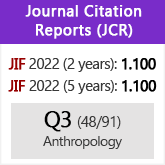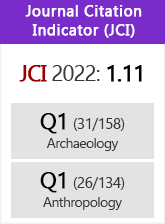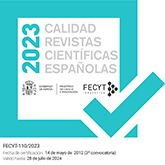A new engraved Magdalenian pendant from the Aizkoltxo site (Mendaro, Gipuzkoa)
DOI:
https://doi.org/10.3989/tp.2023.12324Keywords:
portable art, Cantabrian region, Upper Palaeolithic, ornament, bone pendantAbstract
Engraved pendants are one of the most well-known ornaments used by hunter-gatherers during the Magdalenian. In this paper, we present a new pendant found in the cave of Aizkoltxo (Mendaro, Gipuzkoa, Basque Country). This object was carefully engraved with both figurative –a red deer hind and two aquatic zoomorphs– and non-figurative depictions –X-shaped motifs and simple lines– on a halved rib where a single perforation was produced bipolar drilling. It has been dated to the Final Magdalenian, a moment when the site was heavily used, judging by the abundance of lithics, osseous industry, and faunal remains found. The significance of this object does not lie in its uniqueness but in the similarities it has with others in the Cantabrian region (Valle and El Pendo) and southern France (Lortet, La Vache, Arancou, and Chaffaud). This is both because of the bone used, a rib, and the decoration it displays. The marine animals depicted point towards a commonality in the symbolic code of this chronological horizon, indicating ties between the different groups that lived in Western Europe between 16.500 and 13.000 cal BP.
Downloads
References
Airvaux, J. y Mélard, N. (2006). "Regard sur les représentations paléolithiques de Pinnipèdes. Les phoques de La Marche et du Réseau Guy-Martin (Lussac-les-Chateaux, Vienne)". Bulletin préhistoire du Sud-Ouest, 13/2006/2: pp. 135-150.
Álvarez-Fernández, E. (2006). Los objetos de adorno-colgantes del Paleolítico superior y del Mesolítico en la Cornisa Cantábrica y en el Valle del Ebro: una visión europea. Colección Vítor195. Salamanca: Universidad de Salamanca.
Barandiarán, I. (1973). Arte mueble del paleolítico cantábrico. Zaragoza: Departamento de Prehistoria y Arqueología e Historia de la Antigüedad de la Universidad de Zaragoza.
Barandiarán, I. (2006). Imágenes y adornos en el arte portátil paleolítico. Barcelona: Ariel.
Bosinski, G. y Bosinski, H. (2009). "Seals from the Magdalenian site of Gönnersdorf (Rhineland, Germany)". En: Bahn, P. (Ed.). An Enquiring Mind. Studies in Honor of Alexander Marshack. Oxford: Oxbow, pp. 39-50.
Bronk Ramsey, C. (2009). "Bayesian Analysis of Radiocarbon Dates". Radiocarbon, 51 (1): pp. 337-360. https://doi.org/10.1017/S0033822200033865
Chollot, M. (1964). Collection Piette. Art mobililier préhistorique. Paris: Musée des Antiquités Nationales, Éditions des Musées Nationaux, Ministère d'état affaires culturelles.
Chollot, M. (1980). Les Origenes du graphisme symbolique. Essai d'analyse des écritures primitives en Préhistoire. Paris: Fondation Singer-Polignac.
Citerne, P. (1998). "Le thème du poisson dans l'art paléolithique des Pyrénées". Bulletin de la societé prehistorique de l'Ariege-Pyrénées, LIII: pp. 17-64.
Clottes, J. y Delporte, H. (2003). La grotte de La Vache, Ariège : fouilles Romain Robert. II. L'art mobilier. Saint-Germain-en-Laye: Musée des Antiquités Nationales.
Corchón, M. S. (1986). El arte mueble paleolítico cantábrico. Contexto y análisis interno. Centro de Investigación y Museo de Altamira. Monografías, 16. Madrid: Ministerio de Cultura, Dirección General de Bellas Artes y Archivos.
Corchón, M. S. (1992). "La Cueva de Las Caldas (Priorio, Oviedo) II. Investigaciones efectuadas entre 1987 y 1990". En: Excavaciones Arqueológicas en Asturias 1987-1990. Oviedo: Consejería de Cultura. Principado de Asturias, pp. 33-47.
Crémadès, M. (1990). "Analyse et reconstitution technologiques en art mobilier paléolithique. Nouvelles figurations d'oiseaux de La Madeleine (Dordogne)". Paléo, 2: pp. 203-210. https://doi.org/10.3406/pal.1990.999
Crémadès, M. (1998). "Les relations entre les Hommes préhistoriques et la mer d'après les représentations d'animaux marins au Paléolitique supérieur." En: L'homme Préhistorique et La Mer, 120 ͤ Congrés CTHS, Aix-En-Provence. 23-26 Oct. 1995. Aix-en-Provence : CTHS, pp. 141-150.
Daubisse, P., Vidal, P., Vouvé, J. y Brunet, J. (1994). La grotte de Font-de-Gaume. Perigueux: Ed. Pierre Fanlac.
Deffarge, D., Laurent, P. y Sonneville-Bordes, D. (1975) "Art mobilier du Magdalénien supérieur de l'Abri Morin à Pessac-sur-Dordogne (Gironde)". Gallia Préhistoire, 18: pp.1-64. https://doi.org/10.3406/galip.1975.1487
Fritz, C. (1999). La gravure dans l'art mobilier magdalénien, du geste à la représentation : Contribution à l'analyse microscopique. Paris: Maison des Sciences de l'Homme. https://doi.org/10.4000/books.editionsmsh.45325
García-Rojas, M. (2014). Dinámicas de talla y gestión de las materias primas silíceas a finales del Pleistoceno en el País Vasco. Vitoria-Gasteiz: UPV/EHU.
González-Sainz, C. (2007). "El tema del ciervo herido en el arte parietal paleolítico de la región cantábrica. Evaluación iconográfica". Veleia, 24-25: pp. 305-327.
Mujika-Alustiza, J. A. (2006). "Cueva de Aizkoltxo (Mendaro)". Arkeoikuska, 2005: pp. 456-459.
Ochoa, B., Ruiz-González, D., Arevalo-Muñoz, E., Alberdi-Urdalleta, J., Arruabarrena-Astiazaran, J. M. y Mujika-Alustiza, J. A. (2020). "Un bastón multiperforado de la ocupación del Magdaleniense Final de la cueva Aizkoltxo (Mendaro, Gipuzkoa)". Complutum, 31 (2): pp. 205-232. https://doi.org/10.5209/cmpl.72482
Peñalver, X., y Mujika-Alustiza, J. A. (2017). "Los colgantes de la cueva de Praileaitz I (Deba, Gipuzkoa) y sus características formales". En: Peñalver, X., San José, S., Mujika-Alustiza, J. A. (Eds.). La Cueva de Praileaitz I (Deba, Gipuzkoa, Euskal Herria). Intervención Arqueológica 2000-2009. Munibe Monographs. Anthropology and Archaeology Series, 1. Munibe (Antropología/Arkeología). Donostia: Sociedad de Ciencias Aranzadi, pp. 411-451. https://doi.org/10.21630/mmaas.2017.1.16
Reimer, P. J., Austin, W. E. N., Bard, E., Bayliss, A., Blackwell, P. G., Bronk Ramsey, C.… y Talamo, S. (2020). "The IntCal20 Northern Hemisphere Radiocarbon Age Calibration Curve (0-55 cal kBP)". Radiocarbon, 62 (4): pp. 725-757. https://doi.org/10.1017/RDC.2020.41
Ruiz-González, D., Alberdi, J., Arruabarrena, J. M., y Mujika-Alustiza, J. A. (2019). "Depósito arqueológico de la cueva de Aizkoltxo". Arkeoikuska, 2018: pp. 443-444.
Saint-Périer, R. de (1936). La grotte d'Isturitz II. Le Magdalènien de la grande salle. Archives de l'Institut de Paléontologie Humaine, mémoire25. Paris: Institut de Paléontologie Humaine.
Serangeli, J. (2001). "La zona de costa en Europa durante la última glaciación: consideraciones al análisis de restos y representaciones de focas, cetáceos y alcas gigantes". Cypsela, 13: pp. 125-138.
Tejero, J. M. (2013). La explotación de las materias óseas en el Auriñaciense. Caracterización tecnoeconómica de las producciones del Paleolítico superior inicial en la Península Ibérica. British Archaeological Reports. International Series2469. Oxford: Archaeopress.
Tosello, G. (2003). Pierres gravées du Périgord Magdalénien. Paris: CNRS Editions.
Published
How to Cite
Issue
Section
License
Copyright (c) 2023 Consejo Superior de Investigaciones Científicas (CSIC)

This work is licensed under a Creative Commons Attribution 4.0 International License.
© CSIC. Manuscripts published in both the printed and online versions of this Journal are the property of Consejo Superior de Investigaciones Científicas, and quoting this source is a requirement for any partial or full reproduction.All contents of this electronic edition, except where otherwise noted, are distributed under a “Creative Commons Attribution 4.0 International” (CC BY 4.0) License. You may read here the basic information and the legal text of the license. The indication of the CC BY 4.0 License must be expressly stated in this way when necessary.
Self-archiving in repositories, personal webpages or similar, of any version other than the published by the Editor, is not allowed.
Funding data
Eusko Jaurlaritza
Grant numbers IT-1435-22
Ministerio de Ciencia e Innovación
Grant numbers PID2021-126937NB-I00;JC2020-044629-I
Agencia Estatal de Investigación
Grant numbers PID2021-126937NB-I00;JC2020-044629-I
European Regional Development Fund
Grant numbers PID2021-126937NB-I00
Ministerio de Educación y Formación Profesional
Grant numbers FPU16/07266

















